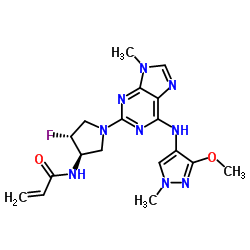1776112-90-3
| Name | Mavelertinib |
|---|---|
| Synonyms |
2-Propenamide, N-[(3R,4R)-4-fluoro-1-[6-[(3-methoxy-1-methyl-1H-pyrazol-4-yl)amino]-9-methyl-9H-purin-2-yl]-3-pyrrolidinyl]-
MFCD29079007 YXX2180047 N-[(3R,4R)-4-Fluoro-1-{6-[(3-methoxy-1-methyl-1H-pyrazol-4-yl)amino]-9-methyl-9H-purin-2-yl}-3-pyrrolidinyl]acrylamide Mavelertinib UNII:YXX2180047 |
| Description | Mavelertinib is a selective, orally available and irreversible EGFR tyrosine kinase inhibitor (EGFR TKI), with IC50s of 5, 4, 12 and 3 nM for Del, L858R, and double mutants T790M/L858R and T790M/Del, respectively. Mavelertinib can be used for the research of non-small-cell lung cancer (NSCLC)[1][2][3][4]. |
|---|---|
| Related Catalog | |
| Target |
IC50: 3 nM (T790M/Del), 4 nM (L858R), 5 nM (Del), 12 nM (T790M/L858R), 307 nM (wild-type)[1] |
| In Vitro | Mavelertinib exhibits selectivity over wild-type EGFR (IC50=307 nM)[1]. Mavelertinib (10 μM) exhibits less than 50% effect or inhibition against all nonkinase targets[1]. Mavelertinib inhibits the hERG26 current with an IC50 > 100 μM[1]. |
| In Vivo | Mavelertinib exhibits low to moderate oral bioavailability (mouse 60%, rat 11%, dog 66%) following oral administration (mouse 1, rat 30, dog 3 mg/kg)[1]. Mavelertinib exhibits short plasma half-lives (mouse 0.56, rat 0.28, dog 1.3 h) due to moderate to high plasma clearance (mouse 53, rat 49, dog 12 mL/min/kg) and low steady-state volume of distribution (mouse 1.48, rat 0.66, dog 0.94 L/kg) following intravenous administration (1 mg/kg to mouse, rat and dog)[1]. Animal Model: Female Nu/Nu mice[1] Dosage: 1 mg/kg (Pharmacokinetic Analysis) Administration: P.o. and i.v. administration Result: Oral bioavailability (60%), T1/2 (1.48 h). |
| References |
| Density | 1.5±0.1 g/cm3 |
|---|---|
| Molecular Formula | C18H22FN9O2 |
| Molecular Weight | 415.425 |
| Exact Mass | 415.188049 |
| LogP | -1.82 |
| Index of Refraction | 1.715 |
| RIDADR | NONH for all modes of transport |
|---|
